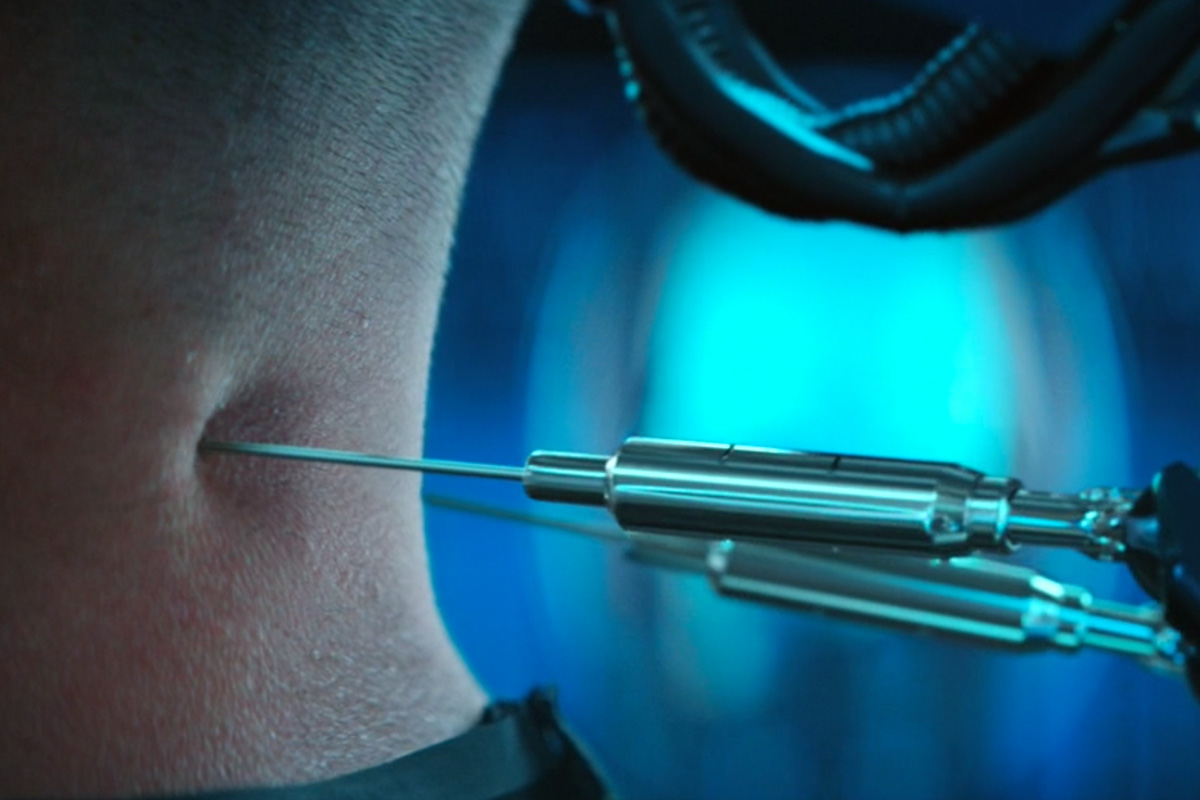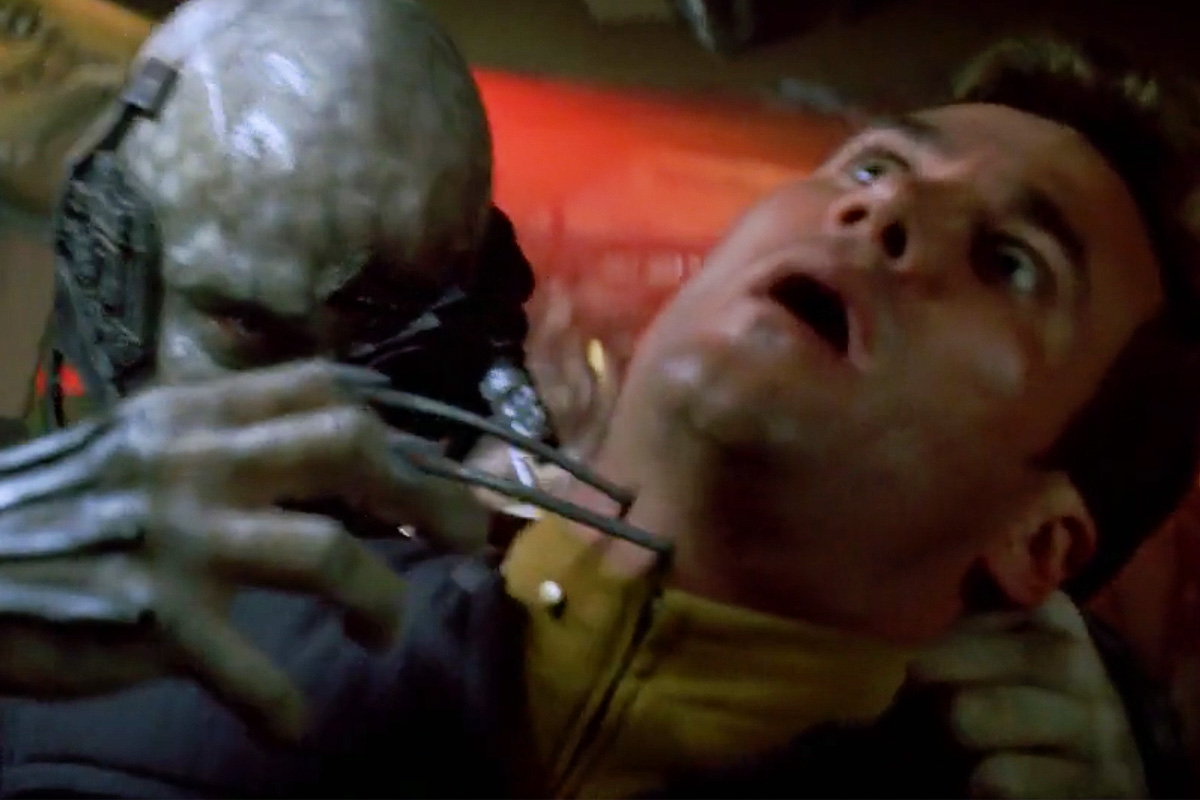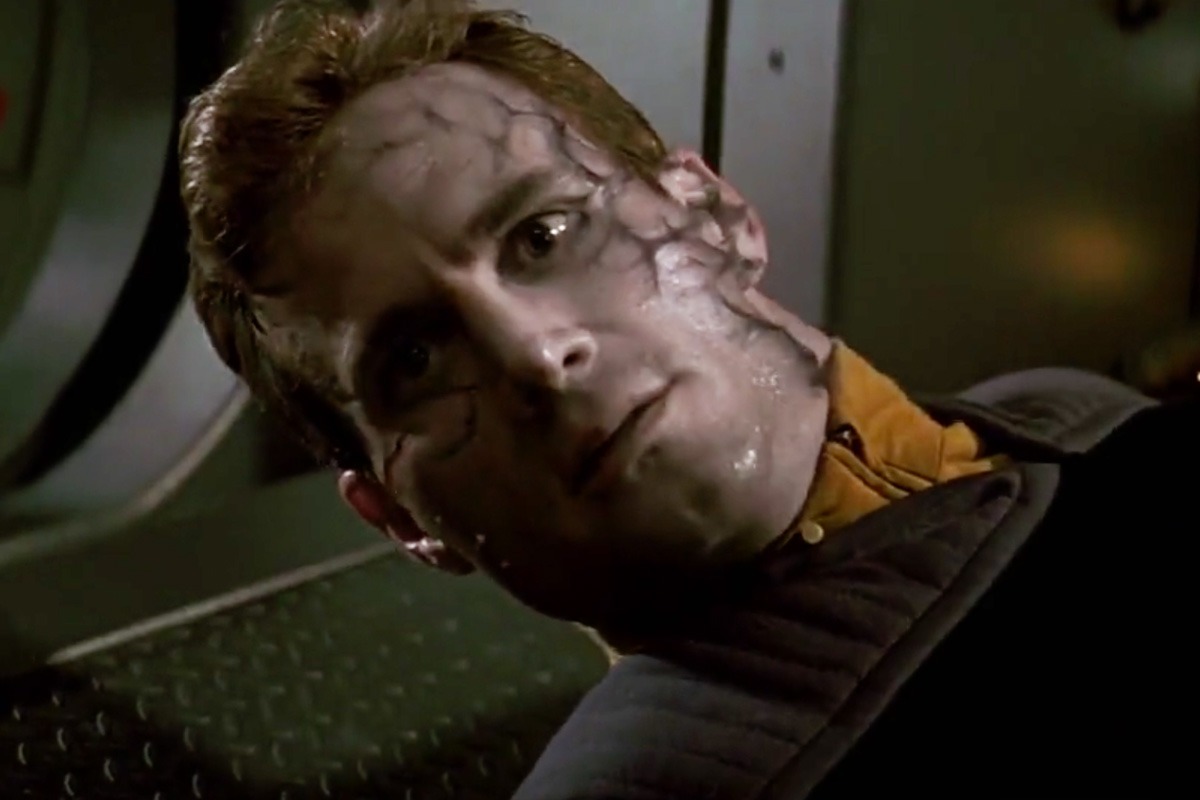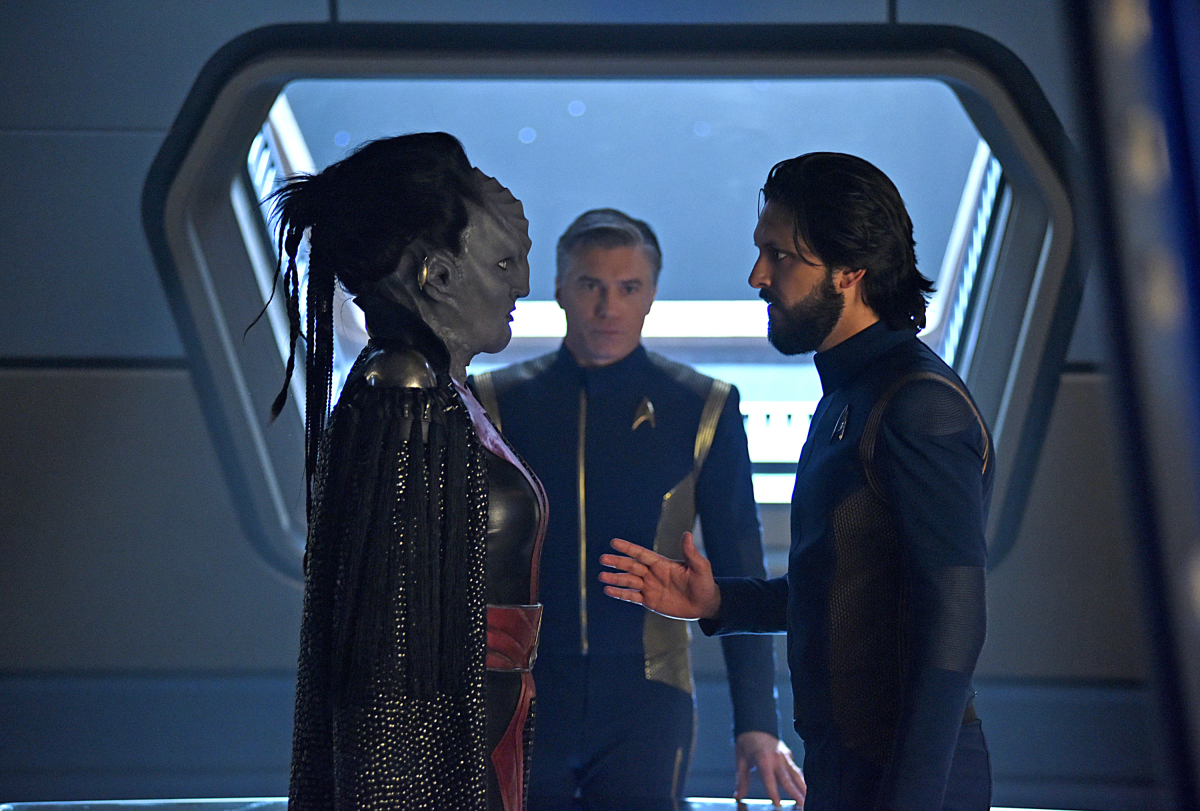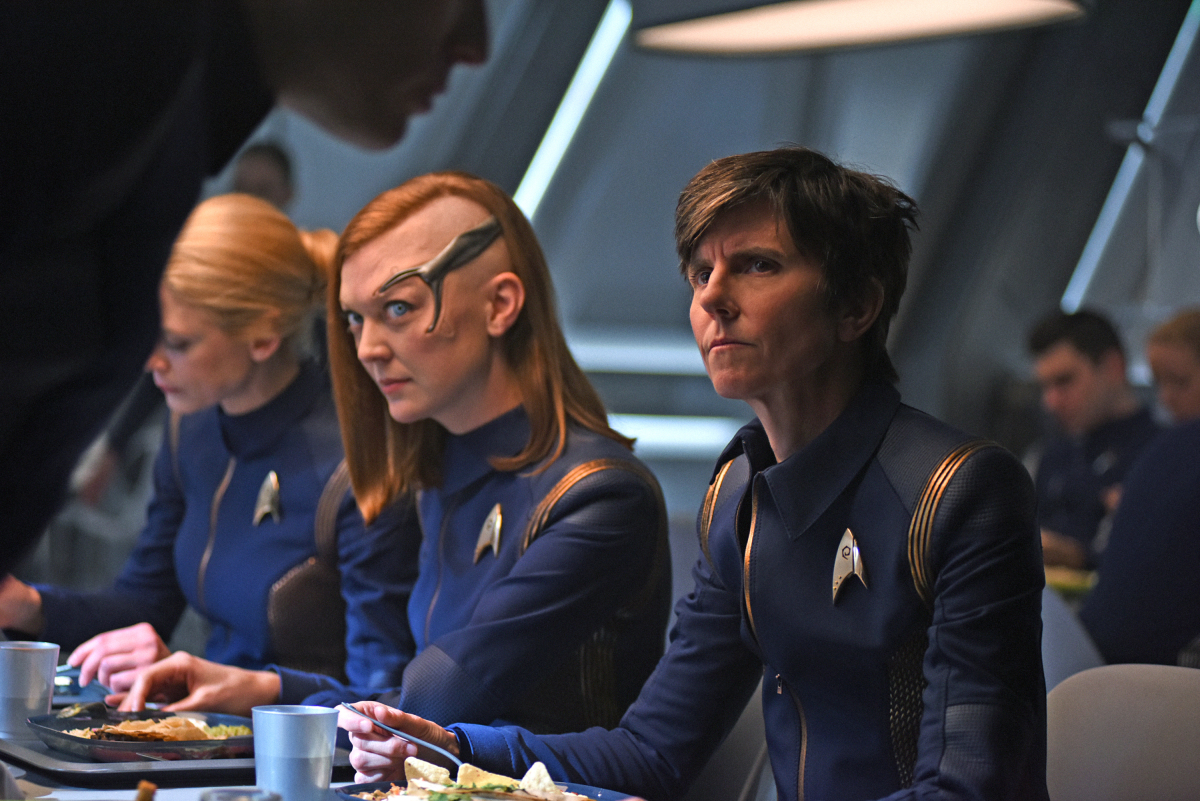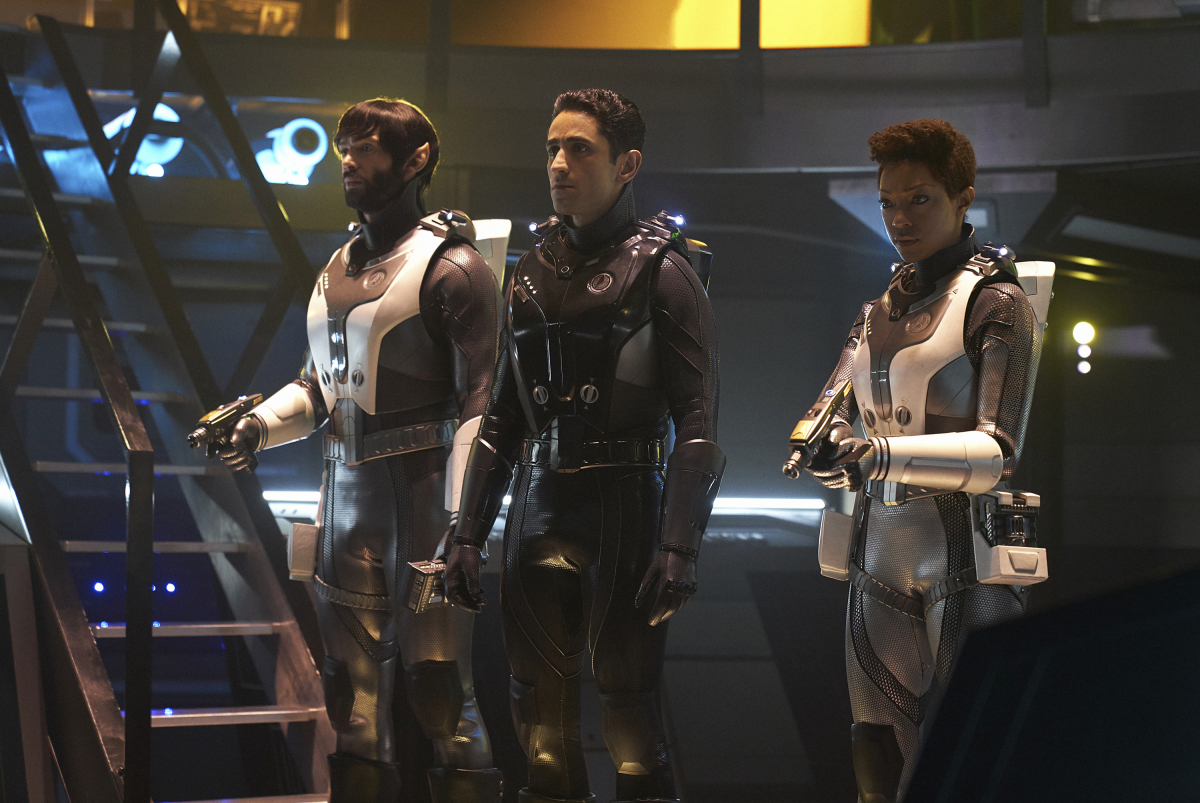'Star Trek: Discovery' Is Guided to a New Time Crystal in 'Through the Valley of Shadows'
An unexpected visit to Boreth yields a surprise.
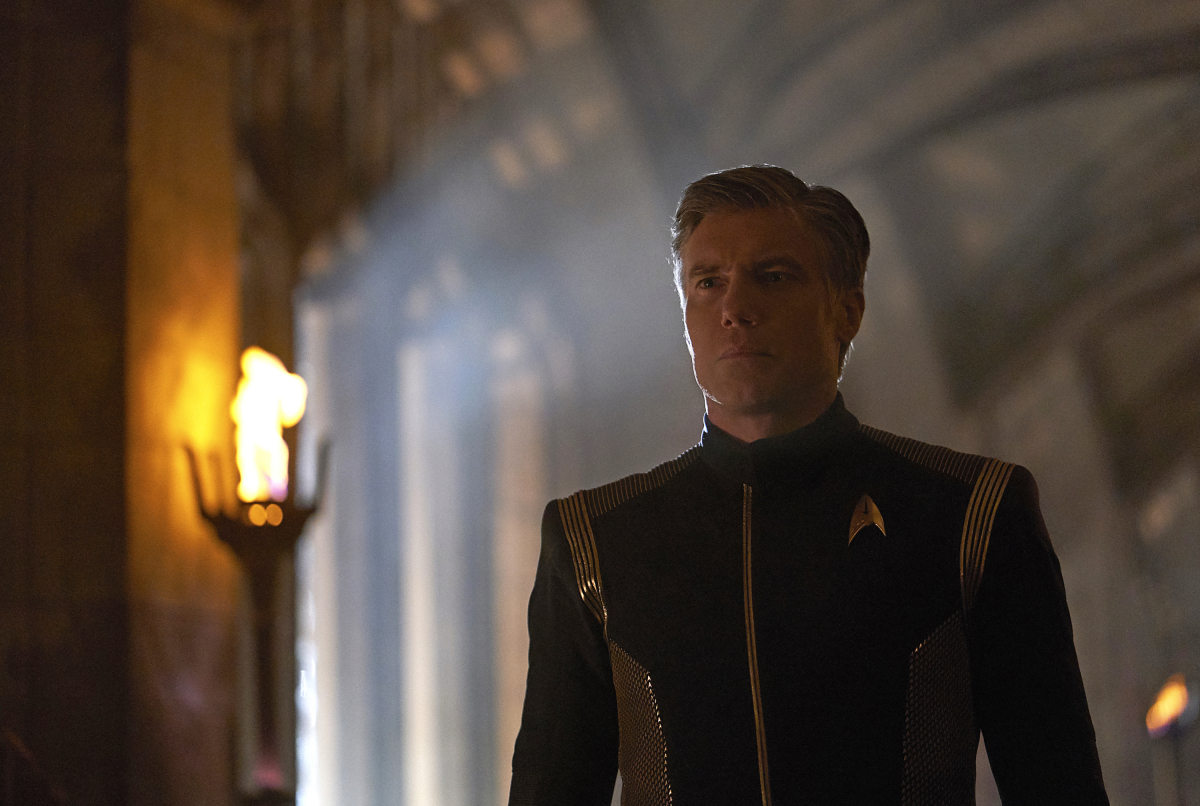
You see, the spoilers enter through the ears and wrap themselves around the cerebral cortex….
Last week's episode seems to have raised more questions than it answered, but probably the biggest single theory circulating the fan base following "Perpetual Infinity" is about what happens to Capt. Leland (Alan Van Sprang) and whether he represents the beginning of the Borg.
It may sound like a belated April Fools' Day prank, but there is, unfortunately, some not unreasonable speculation to at least consider in this highly undesirable outcome.
In essence, it stems from the manner in which Leland is taken over by the AI being referred to as Control. While he's strapped into a strange harness that looks like it's specifically designed for torture and we all wonder how he actually got there, Control sticks a long metal needle into the back of his neck and injects him with what appears to be nanobots … in a way that's very similar to how we've seen the Borg assimilate people in "Star Trek: The Next Generation."
Related: The Evolution of 'Star Trek' (Infographic)
In last week's episode we also saw something distinctly black coursing through Leland's veins on his head and hands, again, very similar to what we've seen in the past, in "Star Trek: First Contact."
Not only is the method of delivery very similar, but there are other little Easter eggs that fit the modus operandi of showrunner Alex Kurtzman: The phrase uttered by Control, "struggle is pointless," could easily be a precursor to the Borg's slogan "resistance is futile," and even the tiny nanobots that transform the unwitting Leland are black and green in appearance, two colors that together are synonymous with the Borg.
Breaking space news, the latest updates on rocket launches, skywatching events and more!
The precise origins of the Borg are unknown in "Trek" lore. As of 1484, they were reported as controlling only a handful of systems in the Delta Quadrant, but by 2373, they had assimilated thousands of worlds. There are a number of theories, including that V'ger from "Star Trek: The Motion Picture" is connected and that a race called the Preservers might be involved. In the novel "Lost Souls" (Gallery Books, 2008), the third book in the "Star Trek: Destiny" trilogy — written by David Mack, who also wrote the "Star Trek: Section 31" novel "Control" — the Borg are revealed to be the survivors of the Caeliar City Mantilis.
The latest episode of "Star Trek: Discovery," "Through the Valley of Shadows," picks the story up not long after the events of last week. Another signal has appeared, the fourth of seven, over the Klingon planet Boreth. Agent Tyler's facial expression when this news is shared in Capt. Pike's (Anson Mount) briefing room reminds us of the significance of this planet from the earlier episode "Point of Light" (S02, E03).
The planet is where the Followers of Kahless established the Boreth monastery. To the Klingons, this is the most sacred location in the Empire. Worf visits the monastery to explore his Klingon heritage in the "Star Trek: The Next Generation" episode "Rightful Heir" (S06, E23). This is where the child of Tyler and L'Rell (Mary Chieffo) was sent to grow up. The baby Klingon would never know his mother or his father, but it would be safe.
Meanwhile, Cmdr. Burnham (Sonequa Martin-Green) is champing at the bit to chase after Leland, but Lt. Saru (Doug Jones) asserts that going after Leland would be unwise as it would put the ship in danger and the sphere data is on Discovery.
Burnham goes to check on Tyler, who shares the story of what had to be done with his son. Not content with having more than enough of her own emotional issues to deal with, Burnham's eyes fill with tears and she says, "I only wish you'd told me, so you wouldn't have to carry it alone."
It's hard to believe she was raised on Vulcan and not Betazed. In all honesty, Burnham's emotional sponge routine is getting a little tired.
After their heart-to-heart, a random beep in the background alerts Tyler that a Section 31 vessel has missed its scheduled routine check-in. Burnham seizes the opportunity and makes preparations to depart.
Meanwhile, a Klingon D7-class battlecruiser — which is always nice to see — carrying L'Rell, now the Klingon Chancellor, meets with the Discovery in orbit above Boreth. Turns out that the monastery was not only built for the Followers of Kahless, but it was also constructed to protect a rare mineral found on the planet …time crystals. Pike assumes the responsibility of retrieving one and travels down to the surface.
Cmdr. Spock (Ethan Peck) insists on joining Burnham, and the two take off in a shuttle to investigate the last known position of the overdue Section 31 ship.
The nice dialogue and interaction between Spock and Burnham is definitely a highlight to this episode, which, in fact, has an effective and enjoyable pace throughout, unlike previous installments. There are some scenes that let it down however; Burnham's endless soaking up of everyone's suffering is one, and the others we'll come to in due course.
We cut to a scene in the mess hall where Cmdr. Reno (Tig Notaro) shows up. We suspected she might after Notaro appeared on late-night TV last week … but where's she been? She joins a table with most of the bridge crew, as they inexplicably all seem to have their break at the same time — even Lt. Nilsson (Sara Mitich) gets to say a few words. Really, though, the purpose of this scene is for us to watch Lt. Stamets' (Anthony Rapp) anguish when Dr. Culber (Wilson Cruz) walks in, setting up a later dialogue between Reno and the good doctor.
This tertiary subplot is interesting to watch unfold and we're not overloaded with dialogue or exposition as both Stamets and Culber each have to deal with different sides of Culber's recent resurrection. Ask any ship's counselor — that's a tough issue to tackle. With two episodes left in Season 2, there should be just enough time for the two to kiss and make up.
Down on Boreth, Pike makes his way to the monastery, which is impressive and looks like something out of "Lord of the Rings." He meets with the monastery keeper, played by Kenneth Mitchell, who has played a few different Klingons throughout "Discovery." It turns out that he's also Tyler and L'Rell's son, now named Tenavik. It seems through the power of the time crystals, or "poH qut," he has aged into an adult. Pike's surprise mirrors our own and while this is an interesting idea, it doesn't really explain how he acquired an adult's worth of knowledge.
This is precisely why time travel is such a minefield for any story, and why its introduction often sparks plot holes and controversy. Just take the "Back to The Future: Part III" two-Deloreans-in-1885 issue. Now, "Star Trek: Discovery" has come along and done a time travel cannonball in the swimming pool of sci-fi.
Related: Time Travel and Wormholes: Kip Thorne's Wildest Theories
The well-written banter between Burnham and Spock continues in the shuttlecraft until they drop out of warp into what appears to be a debris field, except the debris is human bodies — the crew have been blown into space and the Section 31 ship itself is floating, motionless and without power. Burnham and Spock detect a life sign and bring a crewmember on board, barely alive.
Burnham recognizes him as Specialist Kamran Gant (Ali Momen), who also served on the USS Shenzhou before the Klingon War and appeared in four episodes of Season 1. Because they are unable to deduce why the entire crew were killed only for the Section 31 ship to be abandoned, it's clear that Burnham, Spock and Gant must board it.
Meanwhile, in Mordor the monastery, Pike must consent to "know his purpose" and effectively be exposed to a part of his future in order to be granted permission to take a time crystal.
At this point, it's obvious where this episode is taking us. This season of "Discovery" has been as much about Pike as it has been about Burnham. It's given us the chance to see a fully fleshed out character — which has, without a doubt, been the highlight of Season 2. Pike has been an exceptional captain — firm, fair, inspiring and entertaining to watch, and worthy of his name being mentioned alongside James Kirk, Jean-Luc Picard, Benjamin Sisko, Kathryn Janeway and Jonathan Archer.
Perhaps that's what makes this scene so tragic: It reminds us of what's to come, in the not very distant future at all, and it's not particularly pleasant.
Approximately 10 years after the events that we're currently watching unfold, Pike is aboard a training vessel — an old class J starship — when a baffle plate ruptured and exposed many helpless trainees and cadets to deadly delta-particle radiation. Pike drags many cadets from the danger but, in the process, is hopelessly crippled by the rays. Thus faced with a meaningless existence, he eventually returns to Talos IV with Spock's assistance.
One could argue that it's not necessary to actually see the accident, and some quality acting on Mount's part, which we know he's capable of, would have sufficed, leaving just a little of the scene to our imagination. On the other hand, we've always argued that "Star Trek: Discovery" should be written so that anyone can enjoy it, and a Ph.D. in "Trek" Lore from the Andorian Academy of Arts isn't required to understand it. Thus, without showing what he sees, anyone who didn't know Pike's fate might not appreciate the significance of the experience he has by holding the time crystal.
We're just upset that the best thing about "Discovery" will be leaving in two episode's time.
Pike is …distraught, to say the least, with what he sees. Clasping his Starfleet insignia like his life depends on it, he repeats a mantra that we should all be so lucky to be able to say one day: "You're a Starfleet captain. You believe in service, sacrifice, compassion and love."
Tenavik hands him the time crystal and says that by accepting this, Pike's fate is sealed. There will no doubt soon be a thread on Reddit about whether or not he could avoid this tragic fate, given he has substantial knowledge of how it will unfold, but that's for another time.
Back on the Discovery, Reno makes an excuse to have words with Culber in sickbay. In a nice scene, we learn that Reno was married once, but tragically her wife was killed during the Klingon War. If anyone can talk sense into Culber it's Reno. In fact, that's probably why she hasn't appeared for such a long time: If Burnham opened up to Reno instead of carrying all this emotional baggage around, she'd be able to deal with it a lot better and it would cut the number of episodes needed in half. Who needs a ship's counselor; Reno cuts straight through all the nonsense with a refreshingly sharp knife.
Meanwhile, Burnham, Spock and Gant tentatively explore the abandoned Section 31 vessel. They attempt to disguise their efforts to regain higher functions of the ship's computer by running a low-level diagnostic, but it's unsuccessful and the vessel jumps into warp, indicating the Control AI is aware of their presence. A plan is hatched to create a partition of sorts within the ship's computer that will hopefully attract the AI, which can then be trapped within it. Spock goes off to the control room and Burnham and Gant remain on the bridge to enable a manual systems reboot.
Some idle banter between Burnham and Gant raises her suspicions, which turn out to be justified, as — yup, you guessed it — Gant has been taken over by the Control nanoprobes and is now the same kind of cyborg/machine/android that Leland is.
To further add to the ongoing assimilation cliché, it's necessary for Gant's voice to change from a softly spoken, slightly shy human one to an evil-sounding, mechanized, computer-enhanced voice just to reassure us that he is evil and a cyborg/machine/android and not a human any more.
"Once I absorb the sphere's data, I will be the purest form of conscious life in all of existence," Gant says, which also echoes the Borg's idea that they are striving to achieve perfection.
So, the whole overdue Section 31 ship ploy was a carefully crafted trap, intended to lure both Spock and Burnham here so that they may be assimilated and no longer pose a threat to Control. Spock deduces what's going on just as a pretty spectacular firefight between Gant and Burnham begins. It's a race against time as Burnham can only hold off Gant for so long. She grabs another phaser and starts blasting, John Woo-style. Gant takes hit after hit, but keeps on coming. Eventually, the nanoprobes pour out of his body like a mechanical snake and began inching their way toward Burnham, who's now backed up against a bulkhead. At the last possible second, Spock saves her by inducing a magnetic field through the floor panels and immobilizing the micro-sized machines.
"Once I realized the nanobots contained ferromagnetic materials, I had to calculate the correct electrical current to run through the metal in the ship's floor to immobilize them. I apologize for being so slow," Spock says.
They regain control of the ship and it appears Control has been neutralized, at least here. It also appears they have the nanobots contained within a force field, possibly allowing further study once back aboard the Discovery. Spock and Burnham decide it is better to rendezvous with Discovery than to learn where the Section 31 ship was heading. They deduce that the trap was laid so that Control could assimilate Burnham, as it believes she is the one variable it cannot predict. So it seems Burnham is the key to how the future unfolds, which is suggesting more and more that Burnham herself is behind the red signal bursts.
Pike tells Tyler and L'Rell about their son in a moving monologue where he's barely able to hide his own emotion from this recent experience. Back on the bridge, the rogue Section 31 ship has been detected. Then, in a final scene that's reminiscent of the final scene from the episode "This Mortal Coil" (S04, E10) of the vastly underrated "Stargate: Atlantis," 30 or so Section 31 ships suddenly pop up on the viewscreen; Discovery is outnumbered and outgunned and there appears to be very little choice to prevent the sphere data falling into the wrong hands — they must initiate the ship's self-destruct. And cut to black.
This episode isn't without its faults, but there are some great scenes and good dialogue, delivered at an enjoyable pace that doesn't confuse or in any way reduce the viewer's immersion with the story. This is probably our second favorite episode of the second season, after "New Eden" (S02, E02). It is a shame that the rest of the season hasn't been this good.
Two episodes and three red burst signals left. What will next week bring? Whatever it is, we suspect the supernova that young Burnham was so keen to watch the day the Klingons attacked the Doctari Alpha outpost might be involved in some over-complicated time travel back-and-forth. Especially since Gabrielle Burnham mentioned that a power source with the energy of a supernova would be required to break the hold of the time anchor.
The first season of "Star Trek: Discovery" is available to stream in its entirety on CBS All Access in the U.S. and Netflix in the U.K. "Star Trek: Discovery" Season 1 is available now on Blu-ray.
The second season of Star Trek: Discovery consists of 14 episodes with no midseason break. It airs on Thursdays on CBS All Access in the U.S. and on the Space TV channel in Canada; the rest of the world can see it on Netflix on Fridays.
- 'Star Trek Discovery' Hits Emotional (and Exposition) Overload in 'Perpetual Infinity'
- The Identity of the Mysterious Red Angel Is Revealed in This Week's 'Star Trek: Discovery'
- Picard and Riker Reunite! Jonathan Frakes Will Direct New Trek Episodes
Follow Scott Snowden on Twitter. Follow us on Twitter @Spacedotcom and on Facebook.

When Scott's application to the NASA astronaut training program was turned down, he was naturally upset...as any 6-year-old boy would be. He chose instead to write as much as he possibly could about science, technology and space exploration. He graduated from The University of Coventry and received his training on Fleet Street in London. He still hopes to be the first journalist in space.
